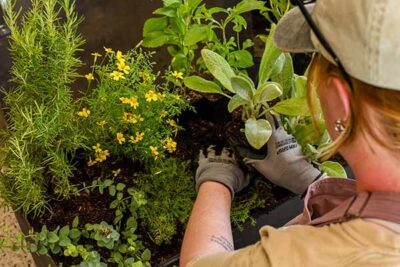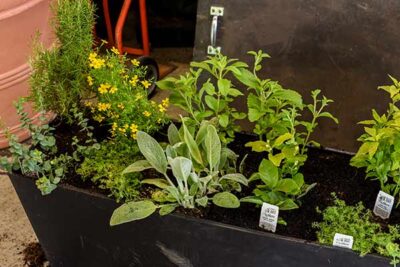By Liz Nye, New England Botanic Garden
June 2025
Ask a horticulturist the recipe for success when creating eye catching container displays, and you’ll likely learn the catchy adage—spiller, thriller, filler. Incorporate a plant that will cascade beautifully over the side of your container. That’s the spiller. Add an exciting “ta da” plant with bold vertical structure—the thriller. Then finish it with a low-growing plant to balance the arrangement and cover the soil—the filler.

Halie pots one of the terrace planters with an assortment of fragrant plants.
Conservatory gardener Halie Poirier was excited to apply this timeless design technique with a new thematic twist when designing the Garden’s terrace boxes this year. Her spillers, thrillers, and fillers are all plants found in herbal teas.
Recently planted, these 11 herbal tea box displays line the terrace overlooking the Wachusett Reservoir. In this space, visitors gather to enjoy food and drink from the Farmer and the Fork café during daytime hours and the Garden’s extended summer hours Wednesdays and Thursdays.
“In the past, the terrace boxes were planted with herbs and vegetables, but this year I wanted to do something a little more focused,” Halie says. “I’m just getting into tea and still kind of a newbie, so as I was doing this, I was learning a lot for myself.”
Combining beauty and functionality was essential to the tea box designs. While mints make popular teas, Halie knew incorporating too many of these quick growing, spreading plants would be a challenge. Instead, she chose other plants, some familiar and others less well-known, paying attention to how they would work together. She considered height, foliage shape and color, and of course, flowers.

Various plants await being placed into the terrace box.
“These tea plants actually have leaves that are beautiful and edible and then flowers that are just super pretty, too,” Halie says. She hopes some of the more unusual tea plants, like Java tea, also called cat’s whiskers (Orthosiphon aristatus), will surprise and delight visitors. Aptly named, this perennial herb native to east Asia produces a conical cluster of flowers with long wispy stamens uncannily reminiscent of a cat’s whiskers.
Another featured plant she’s excited about is a perennial flowering herb called Greek mountain tea (Sideritis syriaca). Commonly known as ironwort, this species originates in the eastern Mediterranean region where it grows at high elevations. It displays soft, silvery foliage and small buttery yellow flowers. It’s known for its savory, earthy flavor and is traditionally used by herbal medicine practitioners for digestive health benefits and anti-inflammatory properties.
In addition to herbal tea plants, the terrace boxes feature a few other “tea-adjacent” plants incorporated for the attributes they bring to the box design.
Halie’s Tea Box Plant List:
- Spiller: English chamomile (Chamaemelum nobile ‘Treneague’), oregano (Origanum ‘Kent Beauty’)
- Thriller: Rosemary (Salvia rosmarinus ‘Barbeque’), lavender (Lavendula stoechas ‘Kew Red’), marigold (Tagetes tenuifolia ‘Lemon Gem’), lemon verbena (Aloysia citrodora), anise-hyssop (Agastache foeniculum), Java tea (Orthosiphon aristatus), stevia (Stevia rebaudiana)
- Filler: Arabian jasmine (Jasminum sambac), Greek mountain tea, (Sideritis syriaca), betony (Stachys officinalis), peppermint (Mentha x piperita piperita), Roman chamomile (Chamaemelum nobile)
To align with the tea theme, Halie also incorporated two potted camellias to the terrace plant displays. (Find them on the side near the Garden Shop, out of the direct sun!) Part of the plant family Theaceae, camellias (Camellia sinensis) are flowering evergreen shrubs native to eastern and southern Asia. Their dark green leaves, leaf buds, and stems are used to produce white, black, green, and oolong teas. These camellias are new additions to the Garden’s existing camellia collection, a collection primarily featuring Camellia japonica and other ornamental cultivars that cannot be used for tea but are instead prized for showy, many-petaled flowers that bloom in shades of pink, red, and white.

The boxes line the railing of the café terrace.
The tea boxes and camellias will be displayed on the terrace all season long. Like most container displays, the boxes will require frequent watering to ensure they don’t dry out. And as many perennial herbs tend to grow fast, frequent pruning will keep the boxes looking their best.
“It’s been really fun to bring this theme to the terrace boxes this year,” says Halie. “I hope that as people enjoy this space at the Garden, the displays spark inspiration and bring forth fond memories of their favorite cup of tea.”
Liz Nye is the Public Relations Manager at New England Botanic Garden. She holds a master’s degree in science writing from Johns Hopkins University and enjoys learning about and writing about all things plants.
